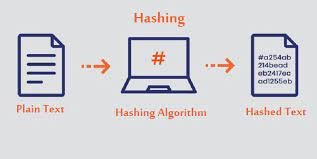THINGS YOU MUST KNOW ABOUT THE HASH ALGORITHM IN DETAIL

Insert the hashing algorithm, which implies “cutting information into manageable, jumbled up parts that make it impossible for the final user to navigate back to the initial formatting.” A proposed hash algorithm is a mechanism that produces a fixed-length output or hash code from a set of information. It differs from encryption within this encrypted data changes actual text to the encrypted message, which is then subsequently converted to an original message using decryption. The original message is turned into a hashed message using cryptographic hashing algorithms in the context of a hash technique, finding it challenging for intruders to decode it. There is no way to return to the actual text, though.
If credential authentication is needed, hashing guarantees that credentials are encrypted and kept in sets with identities in the data frame. Whenever a user enters in, the credential is encrypted and matched to the database table’s encrypted data. If there is indeed a connection, then you are good to go. The visitor is permitted to proceed. Username and password, integrity protection, cryptographic signature, and advanced encryption standard can all be stored using hashtags. They’re used for identification, data sharing, and hash functions, among other things.
What is the best hash function for cryptography you can think of?
A hash function is appropriate for use because of a few fundamental features.
- One-way operations, such as hash functions, are used: Whenever a message has indeed been exposed to a hashing mechanism, there is no way to get back to its initial content. Therefore, if you receive a successful outcome, an appropriate hash function will make very sure you don’t get the sources that resulted in that direct consequence. As you know 6 divided by 2 equals 3. 9 divisible by 3 has already the same effect. However, with only the result ‘3’, it would be impossible to identify the first two digits.
- The avalanche phenomenon is well-utilized by hash algorithms: A specific input yields a specific output, yet even the tiniest modification in the source (even if tiny) causes a considerable shift in the result.
- The computation of hash functions ought to be quick: If somehow the hash function is well-designed, obtaining returns in minutes for just about any particular input information will not be an issue.
- There should be no overlap between the results of the hash function: Two input elements should never have the same result. If you to know the real concept then you must observe the length and range of a hash function.
- The deterministic nature of hash functions: One input parameter’s output must be consistent regardless of when it is checked or even how many times it is used. This is particularly useful when numerous people must be authenticated at various times.
How does the hashing algorithm operate in practice?
At the outset of this post, we discussed passwords and credentials. Let us now discuss data transmission. If someone (let’s call it X) tries to send a document to someone else (let us call her Y). Without the need for a hashing mechanism, the only option for X to verify the information or receivers is to meet with Y in reality. But in today’s hectic, fast-paced, yet very insecure environment, that would have been unpleasant and, in some ways, meaningless. So if the text is lengthy, the documents are large, or the message comprises several different types, styles, and numbers of connections, this procedure can take days.
However, using a hashing method, X can build a verification for the given document (a comparatively tiny piece of digital information generated from some other piece used to detect problems during transfers). When Y obtains the document and checksum, she can apply the very same hashing procedure to it. This guarantees that perhaps the right document has been sent to the right receiver by the appropriate provider.
Privacy Drawbacks of the Hashing Algorithm
Although hashing methods are secure, they are not impenetrable to hackers. An attacker may occasionally be required to supply an input to the hashing algorithm, which can then be utilized for identification. Using brute force attacks, several login tries can be made until a match is located.
Because one precise source can also have one precise result each moment, an attacker will be able to hash a standard passcode like ‘123456’ and get unapproved access. In addition, if numerous people are linked to the very same credentials, the attacker will be overjoyed.
A rainbow table attack, in which an attacker utilizes a vast collection of precomputed hash sequences to gain access to the system, is also popular. Let’s take a look at the biggest and most common password: 123456. Take the Md5 hashing algorithm as an example.
Salting is a procedure that adds more difficulty to the hashed value to organize it much harder to decrypt the passcode. Unexpected information is uploaded to the hash function’s input to produce a significantly more complex outcome. Rainbow table works the best with hash values that haven’t been salted, so this brings another degree of protection.
RASP (Real-Time Application Self-Protection) is an excellent practice to keep an eye on because it identifies threats on an application in an actual time. Safety precautionary is ensured with minimal human interaction and accurate observation of application situational activities. As a result, if any unusual activity is discovered, RASP will guarantee that the session is terminated or that the users receive necessary warnings for any further intervention. They even have an opportunity over firewalls, which only check at the application’s boundary and have no understanding of what’s going on within.
CONCLUSION
Although if enhanced editions of hashing algorithms with an additional level of protection are offered in the marketplace, and SHA-2 appears to be a decent alternative, sometimes it is wise to maintain up to speed with the newest in hashing algorithm development. However, whenever it comes to corporate sustainability or platforms like Appsealing, whereby authentication confirmation and document exchanges are continuous operations all over the globe, the hashing algorithm shines.
To Know More – Queenslandmax



